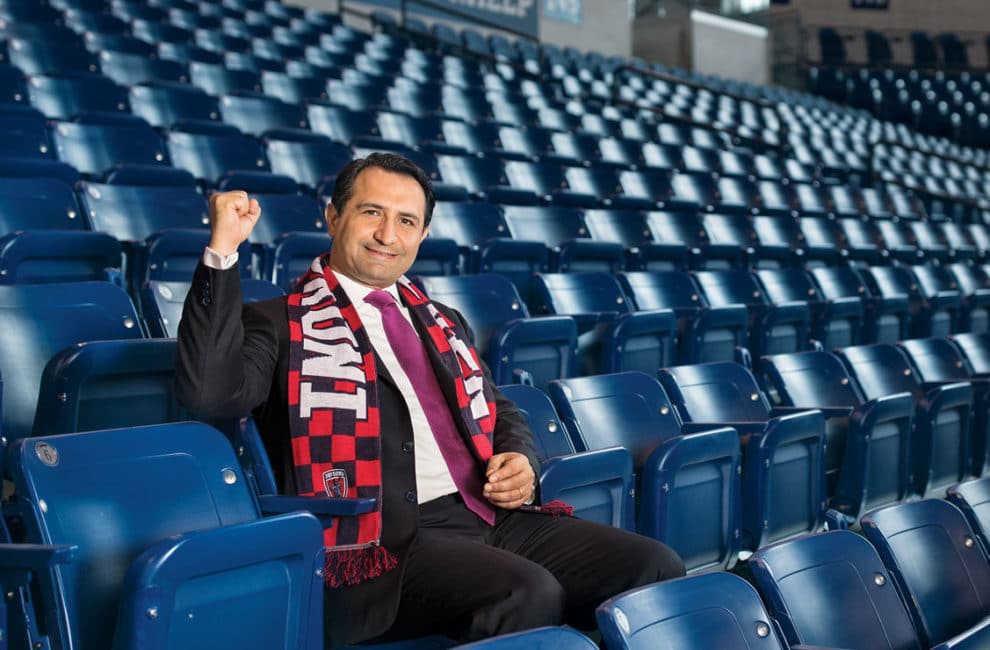
Ersal Ozdemir at Lucas Oil Stadium, the Indy Eleven’s new home—for now. Photography by Tony Valainis
Ersal Ozdemir’s 11th Hour
Ersal Ozdemir, the successful real estate developer with a very expensive soccer habit, seemed tense. Emotionally exhausted from a recent trip to visit his ailing father in Turkey, the Indy Eleven owner had returned home to responsibilities no less daunting. Only days earlier, Ozdemir had pieced together a bid for the Eleven to join the United Soccer League, paying the team’s former league a required $2.5 million early-exit fee. To date, he had only signed one player on an otherwise empty 22-man roster. And then there was the small matter of finalizing a venue for the 2018 season’s games, which would kick off in just two months. Sitting with him in a conference room at Newfields, where Ozdemir is a member of the board of governors, I could tell he wasn’t in the best spirits. So I offered a joke, hoping to lighten the mood. “How do you become a millionaire?” I asked. He looked at me quizzically for a moment before I delivered the punch line. “You start out as a billionaire, and then launch a professional soccer team.”
Ozdemir’s eyes rolled and his head dropped. “That’s true,” he said in his still-thick Turkish accent, having only become a U.S. citizen in 1999. “That’s a very good point. Thanks for rubbing it in.”
We had planned to meet in the cafe, but at the last minute, Ozdemir had requested we move somewhere where we were less likely to be overheard. Ozdemir is known to keep his business dealings close to the vest. That strategy has made him a multi-millionaire, a guy who went from living in a dismal apartment in the 1990s to developing huge projects like Eskenazi Hospital and residing in a mansion in Carmel.

Ozdemir’s proposal for a taxpayer-funded stadium inspired fans, but failed to convince legislators.
But the word among those who follow the Indy Eleven closely is that Ozdemir has sunk somewhere north of $20 million of his own money into that venture and is reaching his breaking point. What began with a great deal of excitement five years ago when he founded the club in the hopes of someday upgrading it to a Major League Soccer team has become a money pit. In four consecutive legislative sessions, state lawmakers turned down Ozdemir’s proposal for a taxpayer-subsidized soccer stadium—a dedicated stadium being an MLS requirement to land an expansion club.
Ozdemir has staked his career on risky projects. Consider the so-called Broad Ripple Parking Garagemahal, a controversial $15 million structure that spurred a flurry of new development in the neighborhood. Or the $60 million Sophia Square luxury apartment building in downtown Carmel, which brought new life to the Arts & Design District where nothing else like it had existed before. “You shake your head a little about the risks Ersal takes sometimes,” a competitor in the city’s development industry told me.
Those risks all paid off, though. So far, the Indy Eleven are a different story. The recent announcement that they’ll play in Lucas Oil Stadium may seem like good news, but in fact, it may undermine the struggling team’s pitch for an arena of their own. As the fifth season heats up this month, Ozdemir is working hard behind the scenes to make sure this isn’t the last. But has one of the city’s most successful dealmakers finally found a game he can’t win?






